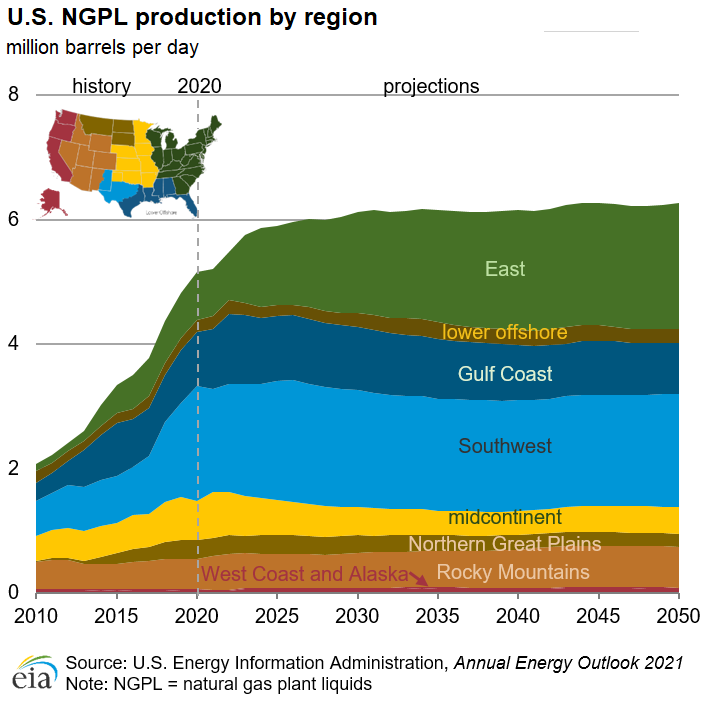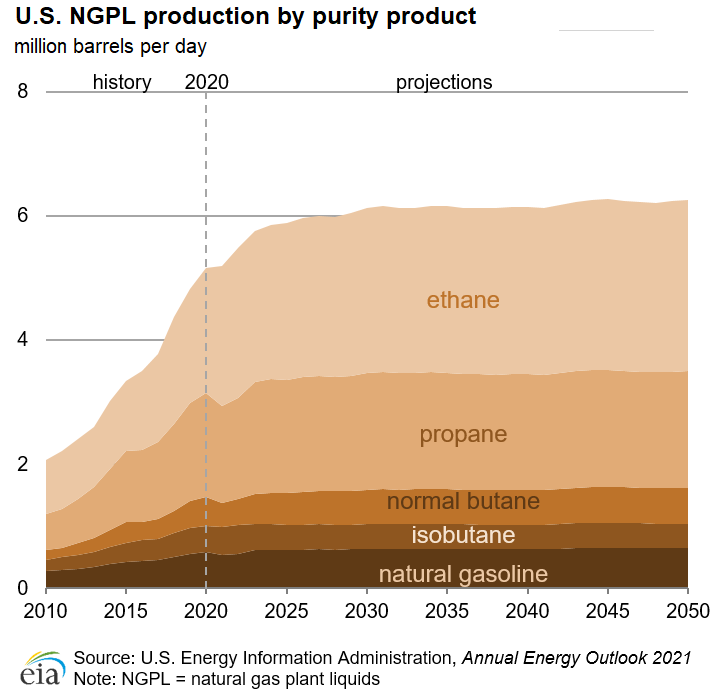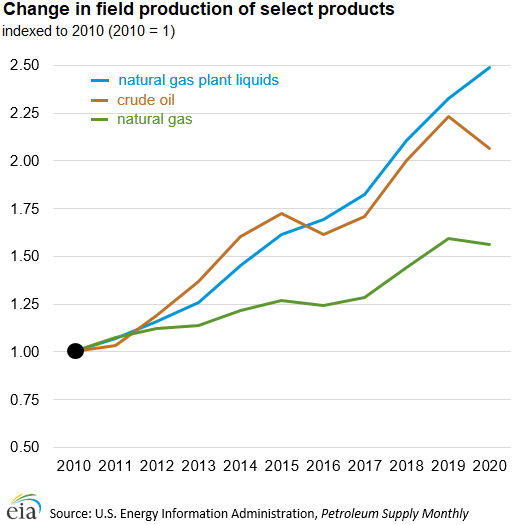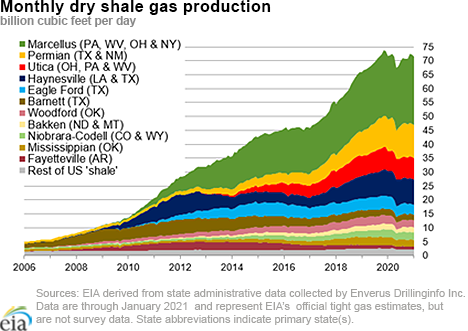In the News:
Natural gas plant liquids production grows in 2020 as crude oil and natural gas production decline
U.S. production of natural gas plant liquids (NGPL), which includes the recovery of ethane, propane, normal butane, isobutane, and natural gasoline from raw natural gas processed at gas processing plants, grew in 2020, even as crude oil and natural gas production declined. U.S. annual average NGPL production grew 7.0% in 2020, reaching 5.2 million barrels per day (b/d). U.S. field production of crude oil and natural gas both decreased over this period, by 7.7% and 1.9%, respectively.
Production of propane from natural gas processing plants—used domestically for space and water heating, cooking, and in the petrochemical industry as a feedstock—increased by 89,000 b/d, or 5.6%. Production of butanes (combined isobutane and normal butane), which are primarily used for finished motor gasoline production, increased by 40,000 b/d, or 4.8%. Natural gasoline, which is also used for motor gasoline blending as well as a diluent in transporting heavy crude oil, increased 26,000 b/d, or 4.6%.
Production of ethane, which serves as a petrochemical feedstock for ethylene crackers, showed the largest increase, growing by 182,000 b/d, or 9.9%. Unlike other NGPLs, natural gas processing plant operators have some discretion in the quantities of ethane to recover from raw natural gas, so ethane production levels generally respond to demand. When demand for ethane, and therefore ethane prices, are low relative to dry natural gas prices, natural gas processing plant operators may choose to leave ethane in the processed natural gas (provided the processed natural gas meets pipeline specifications) and sell it into the natural gas market at its heat value. This process is known as ethane rejection. When ethane prices rise higher than natural gas prices on a heat-value equivalent basis, natural gas processing plant operators may choose to recover the ethane along with other NGPLs and sell it at their market value into the petrochemical sector.
Throughout 2020, ethane prices were, on average, 83¢ per million British thermal units (MMBtu), or 43%, higher than dry natural gas, thus spurring higher rates of recovery. The consistent premium in ethane prices relative to natural gas prices was because of continuing growth in ethane demand for petrochemical feedstock. EIA estimates that petrochemical industry capacity to consume ethane as a feedstock grew by 270,000 b/d as a result of new petrochemical cracking capacity that came online in late 2019 and throughout 2020. Although the petrochemical industry was also affected by the COVID-19-pandemic and associated declines in industrial activity, as well as multiple hurricanes which made landfall along the Gulf Coast, year-over-year domestic demand for ethane as a feedstock grew 165,000 b/d (10.7%). Meanwhile, exports of ethane stayed relatively flat, growing 4,000 b/d.
EIA’s Annual Energy Outlook projects demand for ethane to continue growing into the future. Petrochemical projects currently under construction are expected to add an additional 230,000 b/d of domestic demand. Ethane exports are also expected to increase as overseas petrochemical plants designed to consume ethane imported from the United States are completed. Rising demand and continuing growth in U.S. natural gas production are projected to increase U.S. ethane production by 750,000 b/d, reaching 2.76 million b/d by 2050. Production of other NGPLs is projected to peak in 2031 and remain relatively flat through the remainder of the projection as production of natural gas gradually shifts into areas where the share of NGPLs in the raw natural gas is lower.
Overview:
(For the week ending Wednesday, March 10, 2021)
- Natural gas spot prices fell at most locations this report week (Wednesday, March 3 to Wednesday, March 10) in response to warmer-than-normal temperatures across the Lower 48 states. The Henry Hub spot price fell from $2.84 per million British thermal units (MMBtu) last Wednesday to $2.60/MMBtu yesterday.
- At the New York Mercantile Exchange (NYMEX), the price of the April 2021 contract decreased 12¢, from $2.816/MMBtu last Wednesday to $2.692/MMBtu yesterday. The price of the 12-month strip averaging April 2021 through March 2022 futures contracts declined 10¢/MMBtu to $2.890/MMBtu.
- The net withdrawals from working gas totaled 52 billion cubic feet (Bcf) for the week ending March 5. Working natural gas stocks totaled 1,793 Bcf, which is 13% lower than the year-ago level and 7% lower than the five-year (2016–2021) average for this week.
- The natural gas plant liquids composite price at Mont Belvieu, Texas, fell by 6¢/MMBtu, averaging $7.97/MMBtu for the week ending March 10. The price of ethane fell alongside with natural gas prices, declining 3%. Propane, butane, and isobutane fell by 1%, 1%, and 5%, respectively, as heating- and gasoline-blending seasons wind to a close. The price of natural gasoline rose by 5%.
- According to Baker Hughes, for the week ending Tuesday, March 2, the natural gas rig count remained flat at 92. The number of oil-directed rigs rose by 1 to 310. Miscellaneous rig count remained at 1. The total rig count increased by 1, and it now stands at 403.
Prices/Supply/Demand:
Prices across the country decline as domestic production settles at more than 90 Bcf/d and demand falls in response to above-normal temperatures. This report week (Wednesday, March 3 to Wednesday, March 10), the Henry Hub spot price fell 24¢ from $2.84/MMBtu last Wednesday to $2.60/MMBtu yesterday. The Henry Hub spot price reached as low as $2.55/MMBtu on Tuesday, the lowest price since January 25.
Midwest prices decline by more than 20¢/MMBtu on average as temperatures in the region averaged up to 16ºF warmer-than-average for this week of the year. At the Chicago Citygate, the price decreased 23¢ from $2.76/MMBtu last Wednesday to $2.53/MMBtu yesterday after reaching a weekly low of $2.43/MMBtu on Tuesday. At 63ºF, the average temperature in Chicago yesterday was 27ºF warmer than normal. Prices at Dawn in Ontario, a major natural gas storage hub for the Great Lakes region, decreased 25¢ from $2.75/MMBtu last Wednesday to its weekly low of $2.51/MMBtu yesterday.
California prices declined less than in other markets. Average temperatures in California dropped 8ºF or more lower than average across the state on Tuesday. At 53ºF in Los Angeles and 49ºF in San Francisco, reported average temperatures were 7ºF and 6ºF cooler than normal for the day, respectively. Continuing maintenance on pipelines serving Southern California reduced supply to the state. The El Paso Natural Gas Pipeline reported continuing work near the Hackberry, Arizona, compressor station. Work on Kern River Gas Transmission Company’s Goodsprings Compressor Station outside of Las Vegas, Nevada, also continues. The price at PG&E Citygate in Northern California fell 7¢, down from $3.74/MMBtu last Wednesday to $3.67/MMBtu yesterday, after reaching a weekly low of $3.60/MMBtu on Tuesday. The price at SoCal Citygate in Southern California decreased 10¢ from $3.53/MMBtu last Wednesday to $3.43/MMBtu yesterday. SoCal Citygate prices fell as low as $3.04/MMBtu last Friday before rising in response to cooling temperatures.
Significantly warmer-than-average temperatures in the Northeast lead to rapid price declines in the region. Temperatures across New England rose throughout the report week with average temperatures reaching approximately 20ºF warmer than normal yesterday. At the Algonquin Citygate, which serves Boston-area consumers, the price went down $5.87 from $8.24/MMBtu last Wednesday to a weekly low of $2.37/MMBtu yesterday. At the Transcontinental Pipeline Zone 6 trading point for New York City, the price decreased 80¢ from $2.91/MMBtu last Wednesday to a weekly low of $2.11/MMBtu yesterday.
Appalachia Basin production area prices fall to weekly lows yesterday, in line with falling demand. The Tennessee Zone 4 Marcellus spot price decreased 53¢ from $2.44/MMBtu last Wednesday to $1.91/MMBtu yesterday. The price at Dominion South in southwest Pennsylvania fell 47¢ from $2.50/MMBtu last Wednesday to $2.03/MMBtu yesterday.
Most prices throughout the Permian production region fall approximately 30¢/MMBtu week over week. The price at the Waha Hub in West Texas, which is located near Permian Basin production activities, averaged $2.64/MMBtu last Wednesday, 20¢/MMBtu lower than the Henry Hub price. Yesterday, the price at the Waha Hub averaged $2.35/MMBtu, 25¢/MMBtu lower than the Henry Hub price.
Supply stays relatively flat as increased imports compensate for slight decline in domestic production. According to data from IHS Markit, the average total supply of natural gas fell by 0.1% compared with the previous report week. Dry natural gas production decreased by 0.3% compared with the previous report week. Average net imports from Canada increased by 4.5% from last week.
Demand declines as residential/commercial consumption falls to lowest level for the same week since 2016. Total U.S. consumption of natural gas fell by 4.8% compared with the previous report week, according to data from IHS Markit. Natural gas consumed for power generation declined by 2.9% week over week. Industrial sector consumption decreased by 0.8% week over week. In the residential and commercial sectors, consumption declined by 9.0% as warmer-than-average temperatures across most of the country depressed space heating demand. Natural gas exports to Mexico increased 3.4%. Natural gas deliveries to U.S. liquefied natural gas (LNG) export facilities (LNG pipeline receipts) averaged 10.6 Bcf/d, or 0.87 Bcf/d higher than last week.
U.S. LNG exports increase week over week. Twenty-two LNG vessels (nine from Sabine Pass, five from Corpus Christi, four from Cameron, three from Freeport, and one from Elba Island) with a combined LNG-carrying capacity of 80 Bcf departed the United States between March 4 and March 10, 2021, according to shipping data provided by Marine Traffic.
Storage:
The net withdrawals from storage totaled 52 Bcf for the week ending March 5, compared with the five-year (2016–2021) average net withdrawals of 89 Bcf and last year's net withdrawals of 72 Bcf during the same week. Working natural gas stocks totaled 1,793 Bcf, which is 141 Bcf lower than the five-year average and 257 Bcf lower than last year at this time.
According to The Desk survey of natural gas analysts, estimates of the weekly net change to working natural gas stocks ranged from net withdrawals of 39 Bcf to 104 Bcf, with a median estimate of 67 Bcf.
The average rate of withdrawals from storage is 19% higher than the five-year average so far in the withdrawal season (November through March). If the rate of withdrawals from storage matched the five-year average of 4.9 Bcf/d for the remainder of the withdrawal season, the total inventory would be 1,665 Bcf on March 31, which is 141 Bcf lower than the five-year average of 1,806 Bcf for that time of year.
More storage data and analysis can be found on the Natural Gas Storage Dashboard and the Weekly Natural Gas Storage Report.
See also:
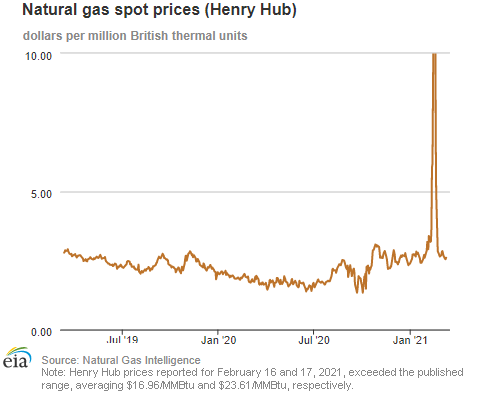
| Spot Prices ($/MMBtu) | Thu, 04-Mar |
Fri, 05-Mar |
Mon, 08-Mar |
Tue, 09-Mar |
Wed, 10-Mar |
|---|---|---|---|---|---|
| Henry Hub |
2.76 |
2.68 |
2.56 |
2.55 |
2.60 |
| New York |
2.84 |
2.79 |
2.35 |
2.24 |
2.11 |
| Chicago |
2.66 |
2.66 |
2.45 |
2.43 |
2.53 |
| Cal. Comp. Avg.* |
3.02 |
2.94 |
2.98 |
2.97 |
3.04 |
| Futures ($/MMBtu) | |||||
| April contract | 2.746 |
2.701 |
2.664 |
2.662 |
2.692 |
| May contract |
2.781 |
2.739 |
2.698 |
2.696 |
2.728 |
| *Avg. of NGI's reported prices for: Malin, PG&E Citygate, and Southern California Border Avg. | |||||
| Source: NGI's Daily Gas Price Index | |||||
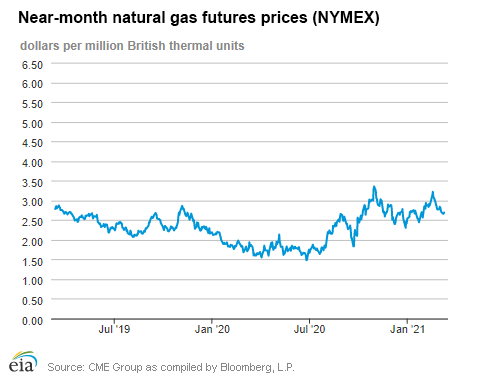
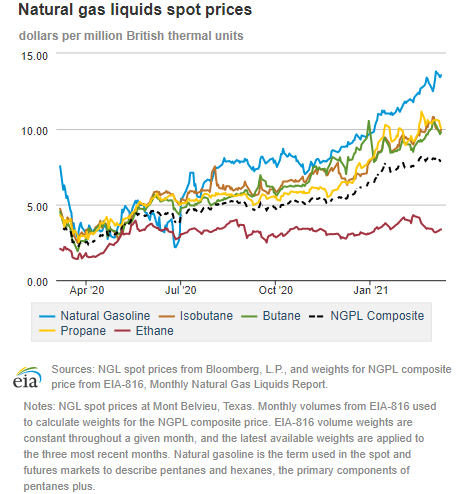
| U.S. natural gas supply - Gas Week: (3/4/21 - 3/10/21) | |||
|---|---|---|---|
Average daily values (Bcf/d): |
|||
this week |
last week |
last year |
|
| Marketed production | 102.8 |
102.9 |
104.9 |
| Dry production | 90.9 |
91.1 |
92.3 |
| Net Canada imports | 4.8 |
4.6 |
3.9 |
| LNG pipeline deliveries | 0.1 |
0.1 |
0.2 |
| Total supply | 95.7 |
95.8 |
96.4 |
|
Source: IHS Markit | |||
| U.S. natural gas consumption - Gas Week: (3/4/21 - 3/10/21) | |||
|---|---|---|---|
Average daily values (Bcf/d): |
|||
this week |
last week |
last year |
|
| U.S. consumption | 80.2 |
84.2 |
79.7 |
| Power | 24.9 |
25.7 |
27.4 |
| Industrial | 24.0 |
24.2 |
23.6 |
| Residential/commercial | 31.2 |
34.3 |
28.7 |
| Mexico exports | 5.7 |
5.5 |
5.4 |
| Pipeline fuel use/losses | 6.6 |
6.8 |
6.8 |
| LNG pipeline receipts | 10.6 |
9.7 |
7.7 |
| Total demand | 103.0 |
106.2 |
99.6 |
|
Source: IHS Markit | |||
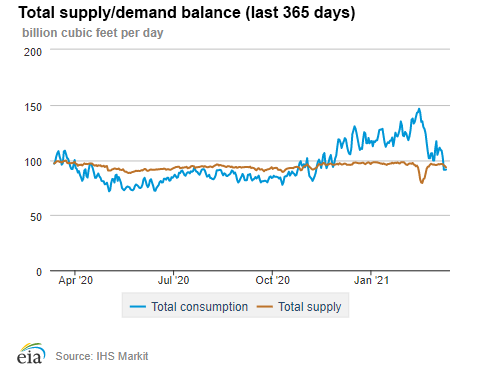
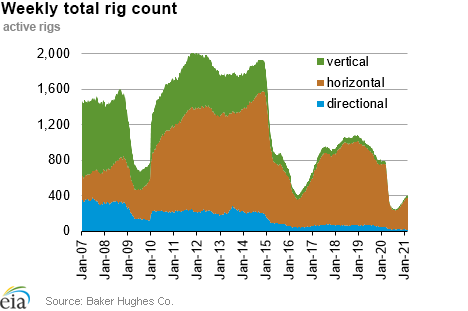
| Rigs | |||
|---|---|---|---|
Tue, March 02, 2021 |
Change from |
||
last week |
last year |
||
| Oil rigs | 310 |
0.3% |
-54.5% |
| Natural gas rigs | 92 |
0.0% |
-15.6% |
| Note: Excludes any miscellaneous rigs | |||
| Rig numbers by type | |||
|---|---|---|---|
Tue, March 02, 2021 |
Change from |
||
last week |
last year |
||
| Vertical | 25 |
0.0% |
-26.5% |
| Horizontal | 362 |
0.8% |
-48.9% |
| Directional | 16 |
-11.1% |
-68.6% |
| Source: Baker Hughes Co. | |||
| Working gas in underground storage | ||||
|---|---|---|---|---|
Stocks billion cubic feet (Bcf) |
||||
| Region | 2021-03-05 |
2021-02-26 |
change |
|
| East | 350 |
383 |
-33 |
|
| Midwest | 440 |
465 |
-25 |
|
| Mountain | 113 |
117 |
-4 |
|
| Pacific | 205 |
210 |
-5 |
|
| South Central | 685 |
670 |
15 |
|
| Total | 1,793 |
1,845 |
-52 |
|
|
Source: Form EIA-912, Weekly Underground Natural Gas Storage Report | ||||
| Working gas in underground storage | |||||
|---|---|---|---|---|---|
Historical comparisons |
|||||
Year ago (3/5/20) |
5-year average (2016-2020) |
||||
| Region | Stocks (Bcf) |
% change |
Stocks (Bcf) |
% change |
|
| East | 430 |
-18.6 |
382 |
-8.4 |
|
| Midwest | 533 |
-17.4 |
473 |
-7.0 |
|
| Mountain | 98 |
15.3 |
109 |
3.7 |
|
| Pacific | 200 |
2.5 |
188 |
9.0 |
|
| South Central | 790 |
-13.3 |
782 |
-12.4 |
|
| Total | 2,050 |
-12.5 |
1,934 |
-7.3 |
|
| Source: Form EIA-912, Weekly Underground Natural Gas Storage Report | |||||
| Temperature – heating & cooling degree days (week ending Mar 04) | ||||||||
|---|---|---|---|---|---|---|---|---|
HDD deviation from: |
CDD deviation from: |
|||||||
| Region | HDD Current |
normal |
last year |
CDD Current |
normal |
last year |
||
| New England | 226 |
-6 |
27 |
0 |
0 |
0 |
||
| Middle Atlantic | 207 |
-12 |
10 |
0 |
0 |
0 |
||
| E N Central | 204 |
-29 |
-26 |
0 |
0 |
0 |
||
| W N Central | 197 |
-36 |
-20 |
0 |
0 |
0 |
||
| South Atlantic | 107 |
-29 |
-30 |
17 |
8 |
11 |
||
| E S Central | 93 |
-38 |
-38 |
4 |
1 |
3 |
||
| W S Central | 64 |
-20 |
-19 |
9 |
1 |
1 |
||
| Mountain | 198 |
20 |
15 |
0 |
-1 |
0 |
||
| Pacific | 106 |
10 |
29 |
0 |
-1 |
0 |
||
| United States | 159 |
-15 |
-6 |
4 |
1 |
2 |
||
|
Note: HDD = heating degree day; CDD = cooling degree day Source: National Oceanic and Atmospheric Administration | ||||||||
Average temperature (°F)
7-day mean ending Mar 04, 2021
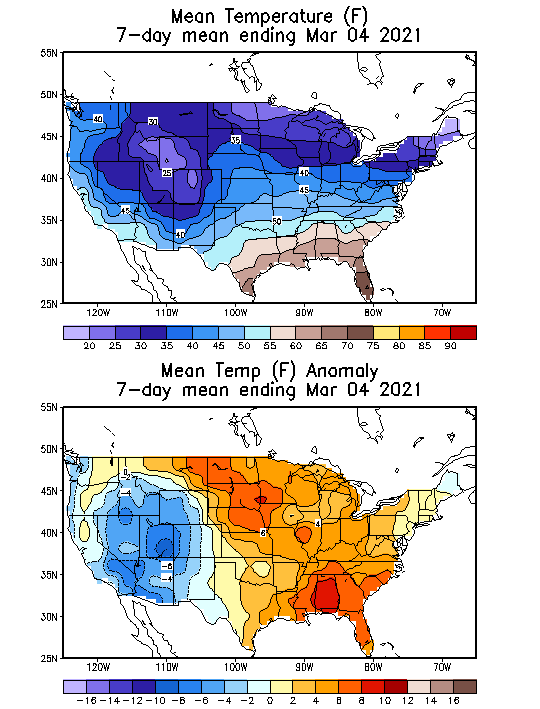
Source: National Oceanic and Atmospheric Administration
Deviation between average and normal (°F)
7-day mean ending Mar 04, 2021

Source: National Oceanic and Atmospheric Administration

